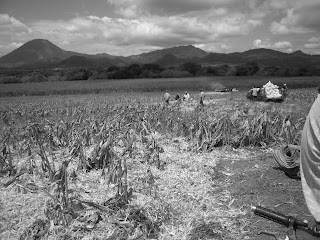Standard in
My Asamblea General was yesterday and had about 85 or 90 attendees. This included 65 men (who are the only people whose presence is actually formally recorded), many women as well, countless children, and a few dogs and chickens to top it all off. Additionally, two or three officials from the closest offices of CENTA (a branch of the Ministry of Agriculture) dropped by. It ended up turning into quite the social event, as during the talks, which took place inside a classroom at the local school, soccer games for the children broke out in the school yard and numerous vendors made brisk business selling everything from oranges to mattresses (the mattresses confused me too, I’m fairly positive no one bought one, and the guy selling them definitely didn’t live here).
The Asamblea General also served to once again remind me of some other large cultural differences between
Additionally, it served as quite the test of my Spanish. I ended up speaking about my time here so far, all that I have learned, and all that I intend to do in my two years for about 15 or 20 minutes. Not only was it, by far, the largest crowd of people I have ever spoken in front of, but it was also completely in Spanish. Making it even more interesting, I’m pretty sure the reason many of the people attended was out of pure curiosity—it still shocks most members of the community that a gringo can not only speak Spanish but can live in their community for more than a few days without fleeing back to the comfort of the States. I didn’t really prepare any remarks because I knew if I had anything written down I would end up getting nervous and just directly reading it off the paper, but all ended up going well—I didn’t even get any outbursts of giggles, the tell-tale sign of Spanish mistakes.
The projects I described range from short-term to long-term, complete necessity to simple quality-of-life projects, agriculture work to rural health work to youth development and environmental education work. This is fairly typical—although my program is specifically geared towards agriculture and farmers, all Volunteers end up having projects across basically every sphere of development work. I will begin my work in November with the construction of latrines. About 40% of the families here have no latrines or broken ones, which is absolutely awful for water quality, soil quality, health, and really basically anything else you can name. Especially since the whole town is on a slope, everything eventually runs downhill and into the river…so if you don’t have a latrine…well, you can figure out what happens. I’m also going to begin with organizing a new environmental youth group for the coming school year and creating a complete, in-depth map of the community, which currently does not exist. The timing of the beginning of when I will begin my work is difficult, because it falls right at the beginning of the corn and bean harvest and the end of the school year, so a lot of my work, especially with farmers and the school, will be pushed back until February. In time, I also plan to organize farmers into groups which can then purchase larger amounts of agricultural products at lower prices, increase the presence of new, more sustainable crops (such as tomatoes, okra, yucca, chiles, radishes, and cucumbers), and work to bring solar-powered lights to the one road that runs through the middle of the community and to the houses without electricity. Additionally, I have already begun a girl’s soccer team and bi-weekly events to teach farmers how to make organic fertilizers and pesticides. While these are just the main projects I have decided to focus on for now, this plan will undoubtedly change quite a few times and I will also constantly be aiding in organization with a few local organizations and institutions and whatever other issues or problems inevitably arise in San Luis on a weekly basis.
However, now that I have finally completed my Asamblea General, the first milestone and goal of any new Volunteer, the work isn’t set to slow down. I will be attending a two-day training event today and tomorrow with the Ministry of Health (I accepted the invitation but forgot to ask what type of training it was—I’m really hoping its not anything too medical, I definitely don’t want to be playing with needles and stuff), my first tournament with my girl’s soccer team on Saturday (promises to be interesting—the girls are quite the motley crew, ranging in age from 10 to 27 and including two mother-daughter duos), and a trip across the country to a beach community on Sunday with the men’s soccer team for another tournament (this one I’ll be playing in, not coaching, thankfully).



















